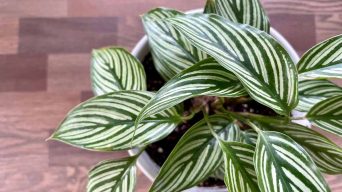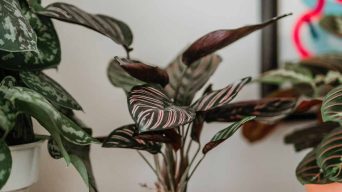It is recommended to water Calathea plants once a week, with the top 2 inches of soil allowed to dry out partially between waterings. During the summer months, it may be necessary to water the plant more frequently, while in the winter, it is advised to water less frequently to prevent overwatering and root rot.
Calathea plants are known for their vibrant green leaves and colorful patterns. However, despite its beauty, it is still a tropical plant that needs to be taken care of properly.
Watering is one of the most important aspects when taking care of a calathea plant. Too little water can cause calathea leaves to curl up or turn yellow, while too much water can lead to root rot and fungal diseases.
Knowing how often and how much water your calathea needs is key to keeping it healthy and beautiful.
This article will discuss everything related to watering calathea plants so you can keep them looking perfect!
Factors Affecting Watering Frequency
Watering calathea plants can be tricky, as there is no one-size-fits-all answer.
Watering frequency depends on a few essential factors that should be considered.
Soil Type
Calathea plants like well-draining, slightly acidic soil that is kept slightly moist.
Ensure that the potting mixture is lightweight and well-ventilated. If it becomes excessively dense, it may retain excessive moisture, leading to issues such as root rot or other complications.
The best type of soil mix should be peat-based with added perlite or vermiculite.
You can also add a layer of gravel at the bottom of your pot to help with drainage.
Humidity
Calathea plants thrive in humid environments, so they will need more water if the humidity is low.
The ideal humidity level for a calathea plant is 50-60%, so you should regularly check the humidity in your home.
In low humidity, you can increase the watering frequency to once every two or three days. In high humidity, water the plant less often – about once a week.
Temperature
Temperature also affects how much and how often you should water your calathea plant.
The soil will dry out in warmer temperatures faster, so you may need to water as frequently as once per week. In cooler temperatures, the soil will retain moisture for longer, so you can water less often – maybe as little as once every two weeks or even less.
Light Exposure
Calathea plants need bright indirect light for optimal growth.
If your plant gets too much light, it will use more water, and you may need to increase the watering frequency.
If it isn’t getting enough light, the soil will retain moisture longer, and you won’t need to water as often.
Observing your plant is the best way to determine the right amount of light. If it’s drooping, it needs more light; if it looks healthy and vibrant, it’s getting enough.
But be careful not to leave your plant in direct sunlight, as a calathea can get sunburned.
Size and Age of the Plant
The size and age of your calathea plant will also affect how much and how often you should water it.
Young and small plants have small root systems and tend to dry out faster, so they need to be watered more often than mature plants.
Mature calathea plants have root systems that are better at storing water, so they need less frequent watering.
Pot Size and Drainage
The pot size and drainage also affect how often to water calathea plants.
If the pot is too small, the soil will dry faster, and you may need to water it more often.
On the other hand, if the pot is too large, there might be too much moisture in the soil for long periods.
The pot should be slightly larger than the root ball to ensure proper drainage and prevent overwatering.
It should also have plenty of drainage holes at the bottom to allow excess water to escape.
How Often Should You Water Calathea Plants
Calathea plants need regular watering, but not too much. Generally, water them once a week during the summer and every two weeks in winter.
However, the specific watering schedule may need to be adjusted depending on the factors discussed in this article. The best way to determine the right frequency is by observing your plant.
Pay attention to the soil moisture and adjust accordingly.
If the soil feels dry to the touch, it’s time to water. On the other hand, if it still feels wet and soggy, leave it until the top few inches of soil have dried out before watering again.
How to Tell if Your Calathea Needs Water
Watering calathea plants is an integral part of keeping them healthy and vibrant. Knowing when it’s time to water your calathea is vital.
Testing the soil moisture is the best way to tell if your calathea needs water.
Calatheas need even moisture in the soil, so stick your finger into the soil up to the second knuckle. If it feels dry, then it’s time to water. If it still feels slightly damp, wait a day or two before watering.
Knowing the signs of overwatering and underwatering is also helpful. These signs can help you adjust your watering frequency and amount.
Signs of Overwatering
Overwatering is a common problem with calatheas. It can lead to several issues, including root rot and fungal diseases.
The most common signs of an overwatered calathea are:
- Yellowing leaves
- Wilting leaves
- Soil that’s soaked and soggy
- Mushy stems and leaves
- Root rot
Signs of Underwatering
Underwatering can also cause health issues for your calathea. When plants don’t get enough water, they can become dehydrated, and their leaves will dry out.
The primary signs that a calathea is not receiving sufficient water include:
- Drooping leaves
- Curling leaves
- Dry, crispy leaves
- Brown spots on the leaves
- Dry, cracked soil
By observing your plant and monitoring the soil moisture, you can determine the right amount and frequency of watering for your calathea.
Watering too much or too little can cause health problems, so adjust accordingly.
Techniques for Proper Watering of Calathea Plants
Calathea care begins with proper watering. Understanding the frequency, amount, and timing of watering your indoor plant is necessary for keeping it healthy and vibrant. Here are a few tips to help you get started.
Understanding the Frequency of Watering
The frequency of watering your Calathea will depend on several factors, such as the type of soil used, the size and maturity of your plant, and even the season.
Generally speaking, Calatheas should be watered once per week, but this can vary depending on the conditions mentioned above.
To check if your Calathea needs water, feel the top inch of soil – if it feels dry, it’s time to water.
Determining the Right Amount of Water to Use
When watering a Calathea plant, use enough water to run out the drainage hole at the bottom of the pot. This ensures that all the soil is saturated with water and prevents root rot from occurring.
The amount of water needed can depend on the size of your pot and the type of soil used. As a general rule, use about one cup of water for every six inches in diameter of the pot.
Choosing the Best Time of Day to Water
The best time to water your Calathea is in the morning, giving the plant the entire day to absorb the water.
The plant will also have plenty of time to dry off before nightfall, reducing the risk of fungal diseases.
Steps for Proper Watering of Calathea Plant
To ensure a healthy, thriving Calathea plant, there are several steps to water it properly.
- Before watering, check the soil of your Calathea plant for moisture levels by feeling it with your fingers or a shovel. Don’t water until the soil is dry on top if it’s damp.
- Use lukewarm or tepid water when watering your Calathea plant. Cold or hot water can cause shock to the roots, resulting in wilting and other problems.
- When watering, ensure that the entire soil is moistened, not just one area. Use enough water so that it runs out of the bottom of the pot to flush away any excess fertilizer or salts.
- Water slowly and consistently to avoid flooding the soil and causing waterlogging.
- Water your Calathea plant evenly and deeply until the water begins to flow out of the bottom of the pot. This will help ensure that all parts of the soil get moistened.
- After watering, allow any excess water to drain away from the pot. Do not leave your Calathea plant standing in water.
- Remove any excess water from the saucer or tray that may have collected after watering. This will help prevent root rot and other problems.
- Keep an eye on your indoor plant and monitor the soil moisture levels. Aim to water approximately once a week or when necessary, depending on light, temperature, and humidity conditions.
These steps will help ensure your Calathea plant is well-cared for, healthy, and thriving!
Bottom Watering
Bottom Watering is another method to consider for proper watering of Calathea plants.
Bottom watering involves placing the pot in a saucer or tray with water and allowing the plant to absorb water from the bottom up. Here’s how to do it:
- Choose a saucer or tray slightly larger than the base of the Calathea’s pot.
- Pour water into the saucer or tray until it reaches a depth of about half an inch. Ensure the pot is not submerged in water but sits on top of the water in the saucer.
- Allow the plant to absorb water through the drainage holes in the pot’s bottom. This can take anywhere from 30 minutes to a few hours, depending on the size of the pot and the moisture needs of the plant.
- Monitor the water level in the saucer. Once the topsoil becomes moist, remove the pot from the saucer and let any excess water drain out.
Bottom watering can be an effective method for preventing overwatering and ensuring that the plant’s roots receive adequate moisture without the risk of waterlogging.
It’s especially useful if you find it challenging to gauge the right amount of water when top watering.
However, it’s essential to note that bottom watering should not replace top watering entirely.
It’s a supplemental method that can be used with regular top watering to maintain the overall health of your Calathea plant.
Be sure to monitor the moisture levels in the soil and adjust your watering routine accordingly to meet your specific plant’s needs.
Common Mistakes to Avoid When Watering a Calathea Plant
When it comes to taking care of a Calathea plant, there are certain mistakes you should avoid.
- Using tap water: Calathea plants are sensitive to fluoride, chlorine, and other minerals found in tap water. It is best to use filtered or distilled water for your Calathea.
- Using a pot with poor drainage: Calathea plants need well-draining soil, so be sure to use a pot with good drainage holes. If there aren’t any, drill some at your pot’s base.
- Using a pot that is too small: Make sure that the pot you are using is big enough for your Calathea. Rootbound plants are more prone to disease and poor growth.
- Using the wrong soil: Calatheas need well-draining, slightly acidic soil to thrive. Avoid using a potting mix that is too heavy or has poor drainage.
- Watering with cold water: Calatheas like warm water and cold water might shock them, so it is best to use room temperature or slightly warmer.
Final Thoughts
When watering Calathea plants, the most important thing is to pay attention and get a feel for the frequency of your particular plant’s needs.
There are no hard and fast rules, so learning to read your plant and adjust accordingly is critical. Keep going even if you make a mistake with over or underwatering.
With consistent attention and care, your Calathea plant should thrive for years.
Happy gardening!







